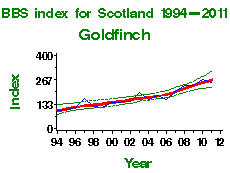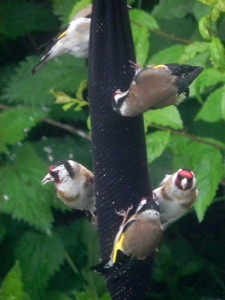Goldfinches

Officially the first bird of paradise (its taste for thistle seeds led to it becoming associated with the Passion and Christ’s crown of thorns) the goldfinch took a worrying decline in the 1970s and 80s. Believed to be connected to the increased use of herbicides on farmland, greatly reducing the ‘weed’ crop they feed on, the goldfinch has since been moved back up to green status with a little help from individuals with bird feeders. A look through our Visitor Centre bird sightings show that the increase in red faced visitors to the Centre is following a similar pattern to that found throughout Scotland, with a drop in numbers over winter as many migrate south for better weather.

Goldfinches thin bills and light weight means they are perfectly adapted to clinging to thistles while feeding, and are regularly seen attached to our Niger seeds socks in conditions that shake off even the most persistent tree sparrow. But, don’t let their slight build and beautiful appearances fool you, they are far from saintly. With aggressive behaviour towards food, they will attack any bird that comes too near their supply.
Georgina Bowie, Visitor Centre Assistant
Help protect Scotland’s wildlife
Our work to save Scotland’s wildlife is made possible thanks to the generosity of our members and supporters.
Join today from just £3 a month to help protect the species you love.
Preface
Officially the first bird of paradise (its taste for thistle seeds led to it becoming associated with the Passion and Christ’s crown of thorns) the goldfinch took a worrying decline …
